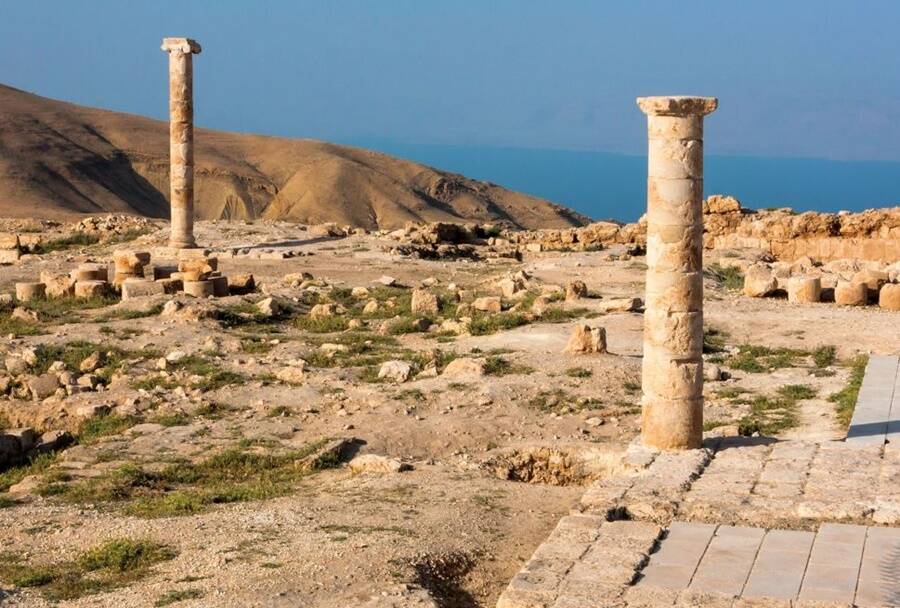According to the Bible, John the Baptist was executed during Herod Antipas' birthday party at the behest of his future stepdaughter.

Győző VörösA 19th-Century painting titled Herod’s Birthday Feast, during which, according to the Bible, John the Baptist was decapitated.
Archaeologists believe they may have uncovered the fortress where John the Baptist was said to have been executed in exchange for a dance, according to the Bible. Excavations of a courtyard discovered at Machaerus in Jordan is suspected to be the place where the infamous exchange took place.
Though there are a few different tellings of the story of John the Baptist’s death, based on biblical texts, it is said that he was executed by Herod Antipas, a son of King Herod.
The incident was also described by ancient writer Flavius Josephus, who wrote that the execution took place at Machaerus, a fort near the Dead Sea in modern-day Jordan, which dates back to 90 B.C.
According to the Bible, John the Baptist was killed at a birthday party for Herod Antipas, which was attended by his future wife, Herodias, and her daughter Salome. Both Herod Antipas and Herodias had been divorced and John the Baptist allegedly did not approve of their impending union.
During the celebration, which was held in the courtyard, Herod’s future stepdaughter Salome performed a mesmerizing dance in his honor. As a reward, Herod Antipas offered her anything her heart desired.
Salome’s mother urged her to call for John the Baptist’s head, and she did. Herod Antipas briefly hesitated before condemning John the Baptist to death. He was, according to the scripture, executed right in the courtyard near where Salome had danced, and she then received John the Baptist’s head on a silver platter.

Győző VörösA reconstructed image of the Machaerus fort where John the Baptist was allegedly executed.
After King Herod’s death, the kingdom was divided among his sons. His territory included Galilee and part of Jordan, but he frequently ruled from Machaerus, where this courtyard was discovered in 1980, but it had never been suspected to be the site of John the Baptist’s gruesome demise — until now.
In the recently published book Holy Land Archaeology on Either Side: Archaeological Essays in Honour of Eugenio Alliata, Győző Vörös, director of the Machaerus Excavations and Surveys at the Dead Sea project, elaborated on the claim that the courtyard found at Machaerus — which translates as “sword” from Greek — was likely where John the Baptist was killed.
Vörös pointed to an apsidal-shaped niche that was uncovered near the courtyard, which he posits are the remains of the throne where Herod Antipas sat during his infamous biblical party.
He also argued that the fort at Machaerus was the only royal palace that Herod Antipas inherited from his father, making it “a perfect place for his birthday party.”
In addition to the courtyard and dance floor, the team found 53 potsherds inscribed in Aramaic, Hebrew, Greek, and Latin, over 10,000 ceramic pieces, cooking vessels, and 137 datable coins, among other artifacts.
“I think it is historically probable that this excavation has brought the ‘dance floor’ of Salome to light,” said Morten Hørning Jensen, a professor at the Norwegian School of Theology, who wrote the book Herod Antipas in Galilee and was not involved in the excavation project at Machaerus.
The discovery is certainly remarkable, though some scholars are not yet convinced that this was really the place where John the Baptist was executed.

Győző VörösColumns of the ancient courtyard in ruins.
For example, Jodi Magness, a professor of religious studies at the University of North Carolina at Chapel Hill, argued that the niche uncovered at the Machaerus courtyard appears much smaller than the throne of Herod Antipas’ father which was previously found.
Moreover, the niche bore similarities to the two niches found at the Upper Herodium, a palace-fortress built by King Herod. Still, Magness praised Vörös’ team’s work and did not rule out the possibility that it could be the courtyard of Herod Antipas as his team claims.
“A perfect match between literary and archaeological sources that places the execution of John the Baptist in that very spot remains to be seen,” added Eric Meyers, a professor emeritus of Jewish studies at Duke University. “In any event, a strong case has been made and I look forward to the final reports.”
For now, Vörös and his team will continue working to complete their project and offer a final analysis of their findings.
Next, read about the 2,800-year-old altar that could be evidence of a biblical war. Then, step into the ancient ruins of Hegra, which had been untouched for 2,000 years — until now.





